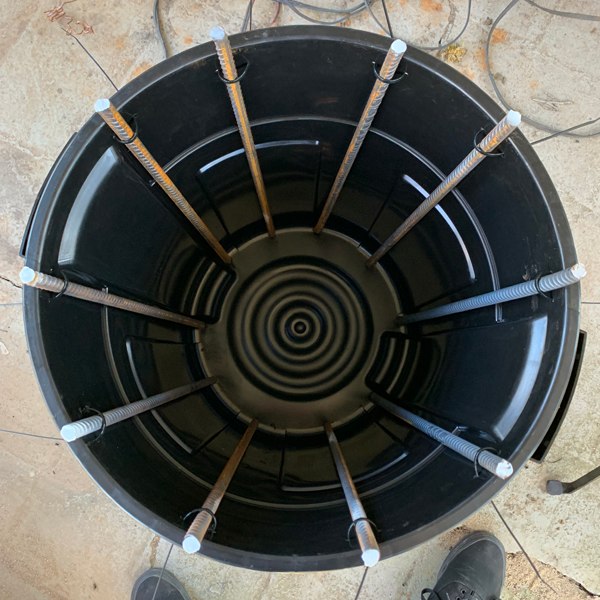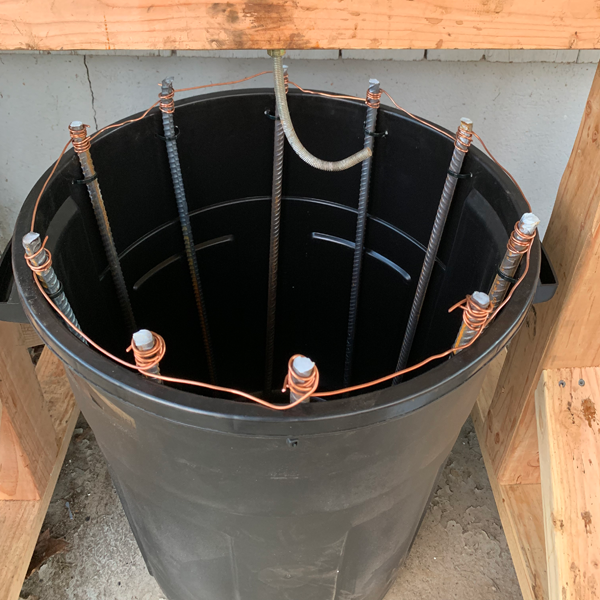Build the equipment used in my cast iron stripping processes
I unfortunately didn't take many photographs when I initially built these, someday I will build them again and take step by step photos, but for now I hope the instructions are descriptive enough!
Lye Bath
Note: Caution must be taken when working with lye. Wear heavy duty, long cuffed, chemical resistant gloves, eye protection, and avoid any exposed skin on your arms and legs. How to Safely Work with Lye
Supplies
- A heavy duty plastic tote or bucket with a lid. Large enough to completely submerge your cast iron with plenty of room to spare to prevent splashing and spilling. I use two 10 gallon totes, both about half full.
- Water. Enough to fully cover your piece or pieces of cast iron (they can be stacked)
- 100% Pure Lye. Between 1/5 - 1/2lb per gallon of water. Most online guides recommend 1/5lb per gallon but I found that to be weak. I've been using a 1:2 ratio for a few years now and I've been very happy with the results
- A second heavy duty plastic tote or bucket (to transfer cast iron from the lye bath to the sink or outdoor rinsing area)
- Eye Protection
- Heavy duty Chemical Resistant Gloves
Instructions
- First, find a safe area to set up your lye bath. If you have children, pets, or roommates in your household you are going to want to set your bath up in an area that they will not be accessing. Lye works better in a warmer environment, so it's common to set lye baths up outside in a sunny area. I personally have mine set up in my basement, which is not ideal for temperature, but I like that it is out of the way and can be used year round. If you live in a colder climate an outdoor lye bath will only work during the warmer months.
- Once you have decided on a location, fill your heavy duty tote or bucket with water. Make sure not to fill to the edge, I would recommend not filling more than halfway. Keep in mind that the water level will rise when you start adding your iron and you don't want your lye spilling out! Depending on the size and style of your container you will probably want to fill it in its final location. I used a bucket to carry water down to my basement to fill my totes rather than try to carry them down full.
- Slowly and carefully add the lye to the water. Never add water to lye!
It's not uncommon to use an aquarium heater in a lye bath ro increase the temperature and effectiveness of the lye. I haven't personally found it necessary so I've never tried it and can't speak to how safe or effective it is.
I decided to go with two smaller lye baths containing about 5 gallons each. Since they are in my basement I wanted to make sure they were small and light enough to be moved around or removed without having to drain them first. Keep this in mind when selecting a container and a location for it.
You're now ready to strip with lye! Visit the Strip page for full instructions on how to use your lye bath
Electrolysis Tank
Note: Always use caution when working with electricity!
Supplies
- A large heavy duty plastic container. I used a medium sized 20 gallon garbage can
- The size of the container: The tank must be large enough to fully submerge the piece you are stripping with enough room around the sides for your anodes without touching. However, you don't want your anodes too far from the piece you are stripping, as the greater the distance the lower the efficiency.
- The shape of your tank: If you're going to use a container that wasn't originally designed to hold gallons of water you may want to wrap a ratchet strap or two around it to give it some additional strength. Round containers will always be better at holding large volumes of water than square or rectangular containers (not designed specifically for holding liquid), but there are benefits to those shapes as well.
- Water (enough to completely cover your cast iron)
- Arm & Hammer Washing Soda a.k.a. Sodium Carbonate. About 1 tablespoon per gallon of water
- Sacrificial Anodes. These should be made of regular steel or graphite. Good sources for anodes include rebar, lawnmower blades, plain steel sheeting, etc. Clean off any significant rust before use or they will not be as effective
- Wire to connect your anodes together (if using more than one). You can go as simple or complicated as you'd like with this, I personally use a number of large alligator clips cannibalized from some extremely cheap harbor freight jumper cable kits, but any wire will do.
- A manual(!) car battery charger. An automatic battery charger will not work. There are not many (if any) new manual chargers still on the market, but older manual chargers can be found for around $20 on craigslist or other online marketplaces. Search for Schumacher brand chargers, they are manual and work great for this purpose. Look for something between 2-10 amps.
- Rebar Tie Wire to hang your cast iron in the tank
- A 2x4 or other frame to hang your cast iron from
When deciding on a container to use for your electrolysis tank there are a few things to keep in mind:
Note: Sodium Carbonate is not the same as Sodium Bicarbonate, a.k.a. baking soda. Regular baking soda will not work without first treating it. If you cannot find Washing Soda you can convert Sodium Bicarbonate to Sodium Carbonate by baking it in the oven at 200 degrees for one hour or so.
There is a seemingly never ending argument on the internet and in cast iron restoration circles about whether or not it is safe to use stainless steel as your sacrificial anode. You will find a lot of arguments on either side. I come down very strongly on the side of Do Not Do It. The science is pretty clear: as the chromium present in stainless steel oxidizes (which is what the sacrificial anode does during electrolysis) it will form hexavalent chromium (chromium 6). Hexavalent chromium, or Hex-Chrome as it is commonly referred, is an incredibly dangerous carcinogen. Some people say hex-chrome can't be formed at the temperatures in an electrolysis tank. This is not true. High temperatures are not required to produce hex-chrome. Some people say the danger is overblown since hex-crome is not airborne and will be washed off your cast iron during the cleaning process. This is a bad idea. Washing hex-chrome down the drain is dangerous and illegal. Finally, even if you are not worried about the giant tank of hex-chrome contaminated water in your backyard or garage, consider what you will do when the water eventually needs to be changed. You will have no safe method of disposing it other than paying a hazardous waste removal service to take it away. Please don't turn your back yard into a superfund site. it's not worth it to save the trouble of occasionally cleaning your anodes.
Make sure no copper wire is directly exposed to the water or you may accidentally copper-plate your iron!
Instructions
- Find a safe location for your e-tank. Mine is set up in a screened-in outdoor patio. I like this location as it's (mostly) protected from the elements, while still having adequate ventilation
- Mount your anodes to your tank. There are multiple ways to do this, and will depend on both your tank and anode choice. For my tank, since I am using rebar and a garbage can, I marked each anode location and drilled a small hole on either side. I then very loosely zip tied each piece of rebar into place. These zip ties should be VERY loose, just enough to keep the rebar from falling over.

- Attach your anodes together. My first version used stripped solid strand copper wire wrapped around each anode to connect to the next one. This got annoying as they needed to be removed to remove the anodes for cleaning. Harbor freight had jumper cable sets on sale for about $5 each, so for under $30 I was able to make some custom jumpers that can be easily removed and re-attached. If you do go with copper wire do not let it come into contact with the water, it may contaminate your tank and cast iron.

- Add Washing Soda to empty tank (it will dissolve easier if added first)
- Add water to tank
- Stir water to help fully dissolve washing soda
- Wrap one end of a length of rebar tie wire around the handle of your cast iron and the other end around your 2x4 or hanging frame
- If using a 2x4, rest it across the top of your tank, hanging the cast iron in the water. Be sure the cast iron is not touching any of the anodes!
- Attach the leads from your charger. The Positive (red) lead attaches to your anodes. The Negative (black) lead attaches to your cast iron or the rebar tie wire that your cast iron is hanging from. Do not hook these up backwards! Attaching the positive lead to your cast iron will cause it to rust and dissolve!
The process of electrolysis produces a small amount of Hydrogen, which can obviously pose a risk if allowed to build up. Many people set them up in basements or garages without issue, but be careful and be sure to have sufficient ventilation wherever you decide to set yours up
Other things to consider
- Electrolysis is largely a line of sight process. When designing and building your tank try to ensure as much "coverage" of your cast iron as possible. Ideally every inch of the piece you are stripping will have a direct line of sight to an anode. This won't be possible for everyone, so if necessary rotate the piece within the tank so that the entire surface has some time directly lined up with your anodes. At a minimum you should have an anode for the front and an anode for the back.
- Be mindful of the temperature of your power supply. These old manual chargers can overheat, especially when using them for something for which they were not designed. On hot days, or if you are running it continuously, consider putting a small fan next to it to help remove the heat that it generates before it damages itself




